Baumgarte T., Shapiro S. Numerical Relativity. Solving Einstein’s Equations on the Computer
Подождите немного. Документ загружается.

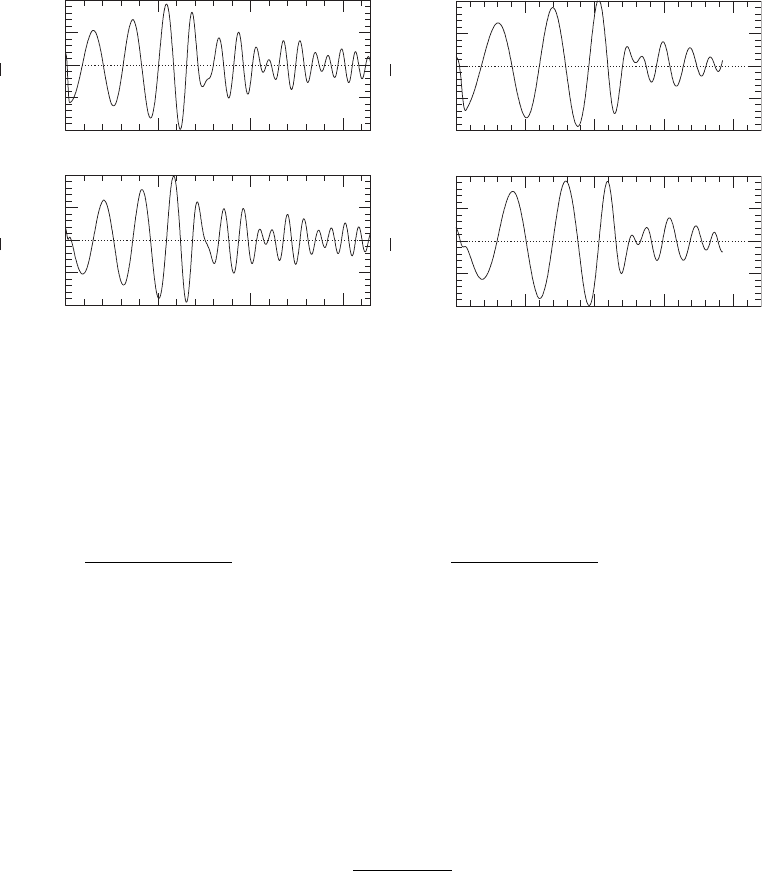
16.3 Fully relativistic simulations 551
0
1
2
1.5
1.5
2
2
Γ = 2.00
Γ = 2.00
(M/R)
∞
(M/R)
∞
= 0.10
= 0.14
31
0.5
0
0
h
×
h
×
h
+
h
+
0
0
2
(t − z
obs
) / P
t=0
(t − z
obs
) / P
t=0
3
1
−0.5
−1
1
0.5
0
−0.5
−1
1
1
1
0.5
0.5
0.5
0
−0.5
−1
1
0.5
0
−0.5
−1
Figure 16.8 Gravitational wave amplitudes
¯
h
+
and
¯
h
×
as functions of retarded time for the n = 1 irrotational
binary neutron star models E and H of Shibata and Ury
¯
u (2002). Model E (left panel) corresponds to a slightly
smaller mass then I1 and results in a differentially rotating hypermassive neutron star, while model H (right
panel) is similar to model I2 and results in a black hole. [From Shibata and Ury
¯
u (2002).]
according to
¯
h
+
≡
z
obs
2M
ADM
(
M/R
)
∞
¯γ
xx
− ¯γ
yy
,
¯
h
×
≡
z
obs
2M
ADM
(
M/R
)
∞
¯γ
xy
. (16.9)
Here z
obs
is the location of the observer. The quantities
¯
h
+
and
¯
h
×
calculated here are
expected to provide a reasonable approximation to the asymptotic gravitational waves, since
the adopted gauge condition is approximately transverse-traceless in the wave zone.
49
Note
that the wave amplitude attains its maximum along the z-axis, along which it is composed
only of |m|=2 modes.
Exercise 16.4 Show that at the point of contact of two equal-mass, spherical,
Newtonian stars in a circular binary, the quadrupole formula gives the amplitude of
gravitational waves along the z-axis to be
h
GW
=
2M(M/R)
∞
z
obs
. (16.10)
This result explains the adopted normalization in equation (16.9).
The difference between the formation of a hypermassive remnant versus a black hole
immediately upon merger is reflected in their waveforms, as seen in Figure 16.8. Quasiperi-
odic oscillations are observed to persist for a long duration for the hypermassive remnant,
49
In the wave zone, the conformally related spatial metric used in equation (16.9) and the physical spatial metric are
nearly equal.
552 Chapter 16 Binary neutron star evolution
while such oscillations last only for a short time scale in the case of a prompt black hole
formation.
Unequal-mass binaries
Following up these simulations, Shibata et al. (2003b) next considered the merger of binary
neutron stars of unequal mass. Here again they adopted a simple -law EOS with = 2
to explore the effect of varying the mass ratio q between 0.85 and 1. This is an appropriate
range to consider, since the mass ratio for all the observed galactic binary neutron stars
for which each mass is determined accurately resides in the this range.
50
The numerical
implementation has been improved in these simulations, beginning with the hydrody-
namics, which is performed by means of an HRSC scheme. Also, the configurations are
followed beginning from the late inspiral phase through the merger phase; this “early start”
allows the transition from inspiral to plunge to be triggered more properly by gravita-
tional radiation reaction, rather than by an artificial initial angular momentum depletion.
A hyperbolic shift equation similar in spirit to the one given by equation (14.44)isusedto
replace the time-consuming elliptic AMD gauge condition. A typical spatial grid size of
633 × 633 × 317 zones is employed in these simulations.
A number of interesting results emerge from this study. If the total rest mass of the system
exceeds approximately 1.7 times the maximum allowed rest mass of a spherical neutron
star, a black hole forms promptly upon merger, independently of the mass ratio. Otherwise
a hypermassive neutron star forms. The disk mass around the black holes increases with
decreasing rest-mass ratios and with increasing neutron star compactness. The merger
process and the gravitational waveforms are sensitive to the rest-mass ratios, even in the
restricted range q = 0.85–1. For example, the maximum amplitude is smaller for models
with smaller mass ratios. This behavior is due to the enhanced role of tidal effects for
smaller mass ratios, causing tidal disruption at larger orbital separation.
51
Also, emission
in modes of odd values of m, which is absent in the case of equal-mass binaries due to
π-rotation symmetry, is not negligible for the merger of unequal-mass binaries, although
the amplitude of this radiation never exceeds 5% of the l = 2, m = 2 mode.
Binaries with realistic EOSs
Having succeeded in simulating binary neutron star mergers for simple polytropes and
-law EOSs, Shibata et al. (2005) proceeded to explore mergers with more realistic
EOSs. They constructed a convenient “hybrid” hot nuclear EOS consisting of two parts,
P = P
cold
+ P
th
. For the cold nuclear matter contribution P
cold
they used both the SLy
52
and
50
Stairs (2004).
51
This effect was reported earlier in Newtonian and post-Newtonian studies; see Rasio and Shapiro (1994); Faber and
Rasio (2000, 2002).
52
Douchin and Haensel (2001).
16.3 Fully relativistic simulations 553
FPS
53
nuclear EOSs, for which the maximum allowed ADM mass of an isolated spherical
neutron star is 2.04M
and 1.80M
, respectively.
54
For the thermal contribution P
th
, they
adopted the law P
th
= (
th
− 1)ρ
0
th
,whereρ
0
is the rest-mass density, and
th
= −
cold
is the specific thermal energy density. To match the stiff behavior of the cold contribution,
they chose
th
= 2, but also experimented with other values.
Exercise 16.5 Assuming that the stars are completely cold when they begin
their plunge towards each other, what physical effect causes them to acquire
nonzero thermal energy? Estimate the resulting characteristic gas temperature in the
gas.
Simulations were performed for binary systems with total ADM mass in the range
between 2.4M
and 2.8M
and with rest-mass ratios q is the range 0.9
<
∼
q
<
∼
1. Uniform
grids with as many as 633 × 633 ×317 zones were employed. They found that when the
total ADM mass exceeds a threshold M
thr
, a black hole forms promptly after merger,
independently of mass ratio. Otherwise a differentially rotating hypermassive neutron star
remnant forms. The value of M
thr
is found to be approximately 2.7M
for SLy and 2.5M
for FPS, which is larger than the maximum spherical or uniformly rotating mass in each
case.
For binaries with total masses exceeding M
thr
, over 99% of the rest-mass forms a black
hole promptly on merger. The spin of the black hole falls in the range J/M
2
≈ 0.7–0.8,
not very different from the spins typically arising from the collapse of rapidly spinning
stars.
55
The quasinormal mode ringdown radiation of the hole will then be at a frequency
f ≈ 6.5–7(2.8M
/M) kHz, which, unfortunately, exceeds the frequency range of optimal
sensitivity of all current laser interferometers.
56
For M < M
thr
the binary results in a hypermassive remnant. In contrast to the remnants
governed by a pure = 2 EOS, the hypermassive remnants formed here are characterized
by a large ellipticity, a consequence of their high spin and high effective adiabatic index.
57
A typical relativistic ellipsoidal remnant is shown in Figure 16.9.
58
The remnant shown here results from the merger of an irrotational binary consisting of
identical neutron stars, each of which has an ADM mass of 1.3M
in isolation. The matter
is governed by the SLy hybrid EOS. The simulation begins from a quasiequilibrium circular
orbit just beyond the ISCO; the initial orbital period is about 2 ms and the merger occurs
after about one orbit. As a result of its spin and high ellipticity, the hypermassive remnant
53
Pandharipande and Ravenhall (1989).
54
For comparison, a -law EOS of the form P = Kρ
0
with = 2 has a maximum ADM mass of 1.72(K /1.6 ×
10
5
)
1/2
M
,whereK is given in cgs units. However, the radii of neutron stars with this -law EOS are considerably
larger than the radii given by the adopted realistic EOSs; see Shibata et al. (2005), Figure 2b.
55
See Chapter 14.2.
56
See Chapter 9.3.
57
Rapidly rotating, nonaxisymmetric quasiequilibria do not exist unless the adiabatic index is sufficiently high. In
Newtonian theory, a uniform rotating Jacobi-like ellipsoid exists only if
>
∼
2.25 and T /|W |
>
∼
0.14; James (1964);
Tassoul (1978).
58
Such triaxial ellipsoids were first seen in the Newtonian coalescence calculations of Rasio and Shapiro (1994).
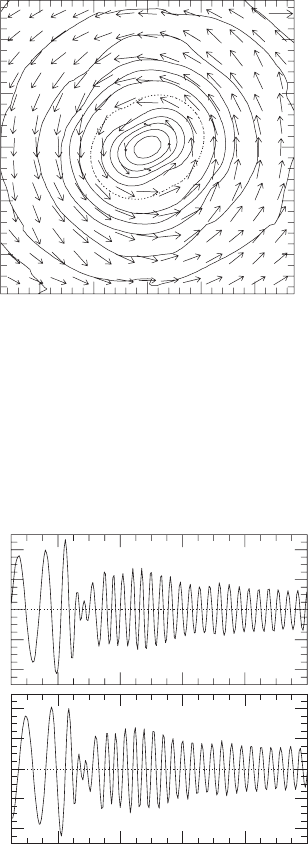
554 Chapter 16 Binary neutron star evolution
20
20
10
10.138
0.3c
10
X
(
km
)
Y (km)
0
0
−10
−10
−20
−20
Figure 16.9 Contours of rest-mass density ρ
0
in the equatorial plane of an ellipsoidal hypermassive
remnant at time t = 10.138 ms. The simulation begins at t = 0 and merger occurs at t ∼ 2 ms. The solid
curves are drawn for contours defined by ρ
0
= 2 × 10
14
× i g/cm
3
(i = 2,...,10) and for
2 ×10
14
× 10
−0.5i
g/cm
3
(i = 1,...,7). The dotted curve denotes the contour near nuclear density,
ρ
0
= 2 × 10
14
g/cm
3
. Vectors indicate the local velocity field (v
x
,v
y
), where the scale is shown in the upper
right-hand corner. [From Shibata (2005).]
0
246
t
ret
(ms)
810
0
4×10
−22
2×10
−22
−2×10
−22
h
+
h
x
2×10
−22
−2×10
−22
−4×10
−22
4×10
−22
−4×10
−22
Figure 16.10 Waveforms for the binary merger that produced the ellipsoidal hypermassive neutron star remnant
depicted in Figure 16.9. The observer is located along the rotational axis of the binary at a distance of 50 Mpc
and t
ret
is retarded time. [From Shibata (2005).]
is a strong emitter of quasiperiodic gravitational waves. The waveforms for the simulation
depicted in Figure 16.9 are shown in Figure 16.10. Their characteristic frequency is about
3 kHz and their amplitude is roughly 1.5 × 10
−22
(assuming a distance of 50 Mpc). These
features hold constant over many rotation periods since the emission damping time, about
50 ms, is very long.

16.3 Fully relativistic simulations 555
Exercise 16.6 Consider gravitational radiation emission in the quadrupole approx-
imation from a uniformly rotating, homogeneous, Newtonian ellipsoid.
(a) Show that the energy and angular momentum loss rates are given by
dE
dt
GW
=
dJ
dt
GW
=−
32
5
6
(I
11
− I
22
)
2
, (16.11)
where I
ii
= Ma
2
i
/5 are the components of the star’s quadrupole moment along the
principle axes in its equatorial plane, a
i
are the semimajor axes in the equatorial
plane, M is the mass, and is the angular velocity, which points in the polar
direction.
(b) Show that the waveform amplitudes of the two polarization states are
h
+
=
2
D
2
(I
11
− I
22
)cos(1 + cos
2
θ), (16.12)
h
×
=
4
D
2
(I
11
− I
22
)sincosθ, (16.13)
where D is the distance to the source, θ is the angle between the rotation axis of
the star and line of sight from the Earth, and ≡ 2
t
dt is twice the orbital
phase.
Gravitational radiation emitted by the nonaxisymmetric hypermassive remnant carries
off angular momentum. Since angular momentum is crucial in holding up the hypermas-
sive remnant against collapse, its dissipation by wave emission will eventually lead to a
“delayed” collapse to a rotating black hole. Unfortunately, the simulations performed here
were forced to terminate long before the collapse. The presence and amplification of a
seed magnetic field can accelerate the process, as demonstrated by simulations presented
in Chapter 14.2.5. Which mechanism dominates the dissipation of angular momentum
probably depends on the initial field strength, the degree of differential rotation, the EOS,
the importance of other dissipative agents, like neutrino emission, and other factors. But
the final fate – delayed collapse – is almost certain.
Shibata (2005) has pointed out that the quasiperiodic radiation from an ellipsoidal
remnant may be sufficiently strong for detection by advanced laser interferometers, even
though the frequency is near the high-end of their current dectability limit. The reason
is that a long-term integration over the many cycles of the wavetrain may increase the
effective peak amplitude above the noise level of detectors like Advanced LIGO. Also,
identifying the chirp signal from the binary during the inspiral phase prior to merger should
improve the search for a quasiperiodic signal from a hypermassive remnant. Detecting such
a quasiperiodic signal will then provide a lower limit to M
thr
, and will therefore constrain
the neutron star EOS. In fact, only a single detection of such a signal is necessary to
furnish a useful constraint. Since the theoretical values for M
thr
found from these binary
merger simulations are quite close to the total masses of the observed binary neutron stars
with accurate mass determinations, binary neutron star mergers leading to hypermassive
remnants might occur frequently.
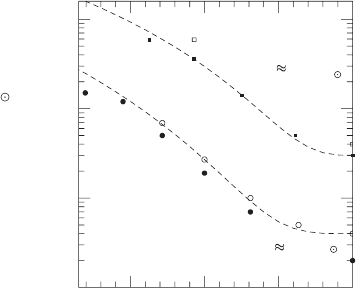
556 Chapter 16 Binary neutron star evolution
0.7 0.8
0.0001
Disk mass (M )
0.001
0.01
SLy, M 2.76M
0.1
0.9 1
APR, M 2.96M
Q
M
Figure 16.11 Baryon rest mass of the disk around the black hole as a function of the mass ratio Q
M
in the case
of prompt black hole formation. The disk mass is evaluated 0.5 ms after the appearance of an apparent horizon.
The open circles and squares denote the results with 633 ×633 × 317 zones for the APR and SLy EOSs,
respectively; the filled circles and squares denote the results with 377 × 377 ×189 zones. The results for the
APR and SLy EOSs are obtained for a total initial binary ADM mass of M ≈ 2.96M
and 2.76M
, respectively.
[From Shibata and Taniguchi (2006).]
Shibata and Taniguchi (2006) have extended some of these calculations in two areas.
First, they use a stiff cold nuclear EOS by Akmal et al. (1998) (APR) in place of FPS. This
choice was motivated by reports of the discovery of a heavy neutron star (pulsar) with a
mass of 2.1 ± 0.2M
.
59
Such measurement would establish a lower limit on the maximum
ADM mass of a spherical neutron star, and it is consistent with the APR maximum mass
(2.18M
), but not the FPS value. Their other motivation was to apply black hole excision
in cases of prompt black hole formation to evolve longer and thereby better determine the
final state of the black hole system. In particular, they wanted to determine the final mass
of the quasistationary disk surrounding the black hole. The disk is an important ingredient
in black hole models of the central engine of short-hard GRB sources, as we have noted in
Chapter 14.2.5. Finally, they wanted to simulate a wider range of mass ratios, 0.65
<
∼
q
<
∼
1.
Collecting their results, Shibata and Taniguchi (2006) conclude that the the value of M
thr
depends on the adopted cold nuclear EOS, but can be approximated by 1.3–1.35M
sph
,where
M
sph
is the maximum mass of a spherical neutron star constructed with the same EOS. Since
uniform rotation can account for mass increases of at most about 20%, differential rotation
is again required to support hypermassive neutron star remnants.
60
Shibata and Taniguchi
59
PSR J0751+1807; Nice et al. (2005). But note that more recent timing observations have led to a substantially lower
mass for this pulsar, 1.26 ± 0.14M
; Nice et al. (2008).
60
ThevalueofM
thr
/M
sph
is thus smaller for stars constructed from realistic nuclear EOSs than for polytropes. This
result is consistent with the finding of Morrison et al. (2004) that, while the maximum mass of a differentially rotating,
hypermassive star is typically 50% larger than the maximum mass of a nonrotating star constructed from the same
realistic nuclear EOS, the increase is less than that for a polytrope.
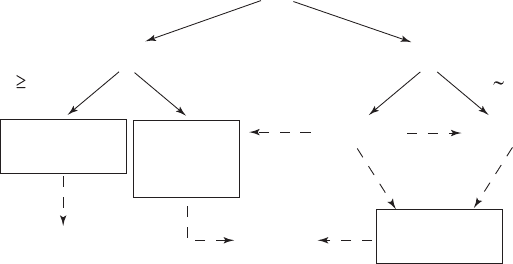
16.3 Fully relativistic simulations 557
Merger
Black hole
0.7− 0.8
< 0.7− 0.8
Black hole
Black hole
+ small disk
no SGRBno SGRB
SGRBSGRB
+ massive
disk
GW
GW
B-field
J-transport
Spheroi
d
HMNS
Ellipsoid
Black hole
+ heavy disk
Q
M
Q
M
M < M
thr
M > M
thr
M M
thr
Figure 16.12 Plausible routes for the formation of a short-hard gamma-ray burst (SGRB) central engine
following the merger of a binary neutron star. Here “HMNS” stands for hypermassive neutron star remnant and
Q
M
represents the mass ratio of the initial stars. For HMNS remnants, “GW” vs. “B-field J-transport” denotes the
outward transport of angular momentum dominated by gravitational wave emission vs. magnetic torques. [From
Shibata and Taniguchi (2006).]
(2006) also find that in the case of prompt black hole formation the disk mass increases
sharply with decreasing q for a fixed ADM mass and EOS, as shown in Figure 16.11.
61
By contrast, in the case of hypermassive remnant formation, followed by delayed collapse
to a black hole, the disk mass is likely to exceed 0.01M
, independently of the mass ratio.
If the dissipation of angular momentum responsible for inducing the collapse is due solely
to the emission of gravitational waves from the ellipsoidal remnant, the disk mass can only
be estimated, and amounts to 0.01–0.03M
.
62
If, however, the dissipation is accelerated
by the amplification of a seed magnetic field in the remnant, the evolution of the system
following collapse can be followed using black hole excision until a quasistationary state
is reached. At this point the disk mass is found to be roughly 0.1M
(see Figure 16.11).
Several scenarios now suggest themselves by which the merger of a binary neutron star
can trigger a short-hard GRB. Some plausible routes are summarized in Figure 16.12.
Another scenario for forming the central engine of a short-hard GRB is the merger of a
black hole-neutron star binary, which we will discuss in Chapter 17. While all of these
61
Shibata and Taniguchi (2006) therefore suggest that a merger with a smaller q may be a better candidate for producing
a short-hard gamma-ray burst central engine.
62
The duration of this nonaxisymmetric secular dissipation process, which typically lasts 50 ms, is too long to be tracked
reliably using a fully relativistic 3 +1 hydrodynamic code like the one of Shibata and Taniguchi (2006). However, it
has been possible to follow this dissipation epoch for incompressible (Miller 1974; Detweiler and Lindblom 1977)and
compressible (Ipser and Managan 1984; Lai and Shapiro 1995a) triaxial ellipsoids in Newtonian gravitation. These
treatments allow for differential rotation (vorticity) and viscosity and incorporate a gravitational radiation-reaction
potential. It is found that in the absence of viscosity, radiation-reaction forces typically drive a Jacobi-like ellipsoid
to a nonradiating triaxial state (a Dedekind ellipsoid), for which = 0 in the inertial frame (a “stationary football”).
Other possibilites exist, however, depending on the vorticity and (conserved) circulation of the configuration. For every
scenario, the emitted quasiperiodic waves exhibit a unique signature that may be detectable by a gravitational wave
laser interferometer; see Lai and Shapiro (1995a) and references therein.
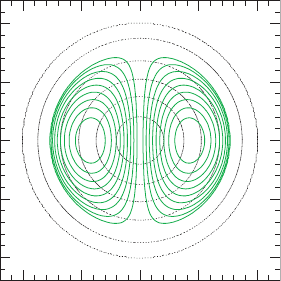
558 Chapter 16 Binary neutron star evolution
0
0
Z/R
1
X/R
0.5
0.5
1
−0.5
−0.5
−1
−1
Figure 16.13 Magnetic field lines in a widely separated, spherical neutron star companion as viewed in the
meridional plane. The star is an n = 1 polytrope with a rest mass
¯
M
0
= 0.146 (the maximum being 0.180 for this
EOS). Dotted (black) concentric circles are rest-mass density contours drawn for
ρ
0
/ρ
max
0
= 0.9, 0.7, 0.5, 0.3, 0.1, and 0.001. Solid (green) lines show representative magnetic field lines; the field
is purely poloidal. Coordinates are in units of the stellar radius R.[FromLiu et al. (2008).]
scenarios still await detailed analyses, it seems clear that numerical relativity is capable of
supplying the computational firepower necessary to construct viable theoretical models.
Perhaps one of the most important roles of numerical relativity will prove to be laying the
theoretical groundwork for the simultaneous detection and identification of a gravitational
wave signal and gamma-ray burst from the same cosmic source.
63
Magnetized binary neutron star mergers
Since neutron stars are threaded by magnetic fields, it is important to assess the effect of
such fields on binary mergers. The exterior fields of the two neutron stars will interact
during the inspiral phase, and in principle this could affect the dynamics and gravitational
waveforms. However, calculations show
64
that an exterior dipole field has a negligible
influence provided the surface field strength is below 10
16
G. Typical neutron stars are
expected to have fields much smaller than this, and only for extreme “magnetars” do
the inferred strengths begin to approach this limit. Any appreciable dynamical effect from
magnetic fields must thus originate from interior magnetic fields and can occur only during
and/or after the merger phase.
The effects of an interior field on binary neutron star merger have been investi-
gated by Liu et al. (2008), who adopted the same basic HRSC GRMHD scheme of
63
Also, simulations coupled with broadband gravitational wave observations at frequencies between 500 and 1000 Hz
may constrain the neutron star EOS and measure its radius to an accuracy of δ R ∼ 1 km at 100 Mpc; Read et al.
(2009).
64
Ioka and Taniguchi (2000).
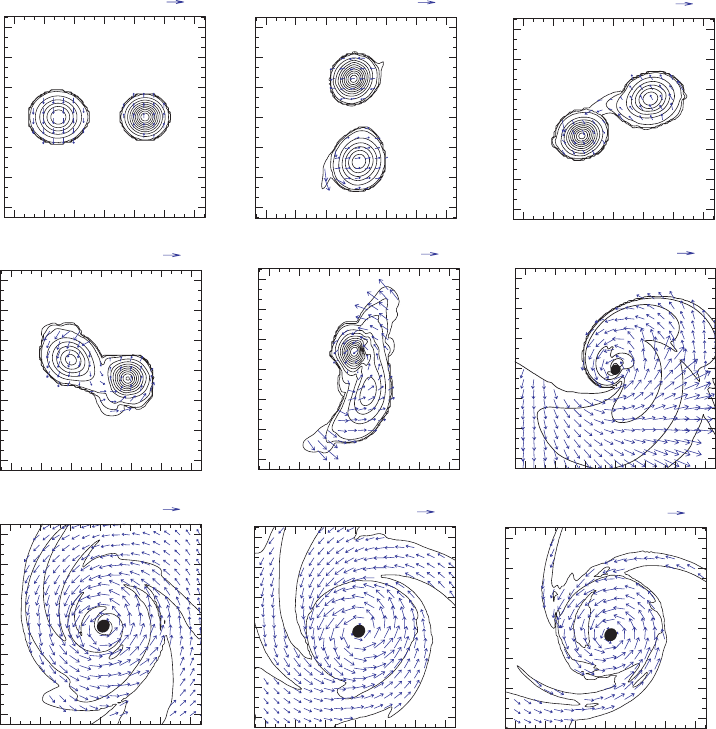
16.3 Fully relativistic simulations 559
9
9
6
6
3
t = 0.0 M
0.5c
3
0
0
Y/ M
Y/ M
Y/ M
Y/ M
Y/ M
Y/ M
Y/ M
Y/ M
Y/ M
Y/ M
−3
−3
−6
−6
−9
−9
9
9
6
6
3
t = 49.7 M
0.5c
3
0
0
−3
−3
−6
−6
−9
−9
9
9
6
6
3
t = 101.4 M
0.5c
3
0
0
−3
−3
−6
−6
−9
−9
9
9
6
6
3
t = 151.0 M
0.5c
3
0
0
−3
−3
−6
−6
−9
−9
9
9
6
6
3
t = 300.0 M
0.5c
3
0
0
X / M
X / M
X / M
X / M
X / M
X / M
X / M
X / M
X / M
−3
−3
−6
−6
−9
−9
9
9
6
6
3
t = 347.6 M
0.5c
3
0
0
−3
−3
−6
−6
−9
−9
9
9
6
6
3
t = 391.0 M
0.5c
3
0
0
−3
−3
−6
−6
−9
−9
9
9
6
6
3
t = 188.3 M
0.5c
3
0
0
−3
−3
−6
−6
−9
−9
9
9
6
6
3
t = 235.9 M
0.5c
3
0
0
−3
−3
−6
−Z
−9
−9
Figure 16.14 Snapshots of the rest-mass density and velocity field in the equatorial plane during the merger of a
magnetized, neutron star binary. The initial binary is irrotational with n = 1 polytropic companions of
unequal-mass (the ratio of rest masses is q = 0.855). The binary has a total ADM mass
¯
M = 0.290, a rest mass
¯
M
0
= 0.317 and an angular momentum J/M
2
= 0.933. Density contours are drawn for
ρ
0
/ρ
max
0
(0) = 0.9, 0.8,...,0.1, 0.01, 0.001, and 0.0001. The initial magnetic field profile in each star is depicted
in Figure 16.13. The 3-velocity vectors are normalized as indicated above each frame. The black circle locates
the apparent horizon. [From Liu et al. (2008).]
Duez et al. (2005b) described earlier in the book and used to evolve rotating, magnetized
stars in Chapter 14.2.5. Liu et al. (2008) evolve binaries constructed via the conformal
thin-sandwich approach for n = 1 irrotational polytropes. Adopting equatorial symmetry,
they employ spatial grids with as many as 400 × 400 × 200 zones in x–y–z directions
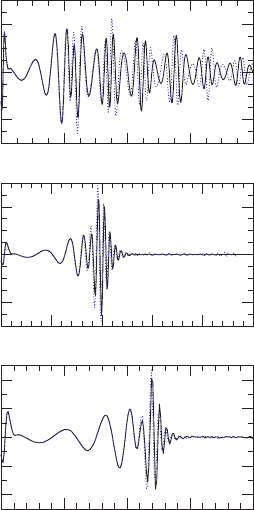
560 Chapter 16 Binary neutron star evolution
0
0.004
−0.004
0.008
0.004
0
0
0
0
0
0.02
−0.02
−0.004
−0.008
200
100
100
300
300
500200
200
400
400
400
(t − r) / M
600
(a)
(b)
(c)
800
Re (rM
y
22
4
)
Figure 16.15 A comparison of gravitational waveforms for neutron star mergers in three different binary
systems; each system is treated with and without magnetic fields. Binary system (a) has low, equal-mass
companions and a total ADM mass
¯
M = 0.269 and rest mass
¯
M
0
= 0.292; it produces a hypermassive remnant.
Binary system (b) has high, equal-mass companions and a total ADM mass
¯
M = 0.292 and rest mass
¯
M
0
= 0.320; it leads to prompt collapse to a black hole. Binary system (c) has high, unequal-mass companions
and a total ADM mass
¯
M = 0.290 and rest mass
¯
M
0
= 0.317; it also leads to prompt collapse to a black hole.
The merger of system (c) is highlighted in Figure 16.14. The solid (dotted) lines show the waveforms for
unmagnetized (magnetized) binaries. [After Liu et al. (2008).]
(with the binary rotation axis along z) and use a simple FMR scheme
65
to enhance the
resolution and dynamic range. As a check, they first repeated the simulations of Shibata
et al. (2003b) for several unmagnetized cases, using the same initial data as in Shibata et al.
(2003b), and found good agreement. For cases in which the mergers result in a prompt
collapse to a black hole, Liu et al. (2008) employ moving puncture gauge conditions
(Chapter 4.3) to extend the simulations in time to better determine the final mass of any
debris that remains in an ambient disk about the remnant hole. They find that the disk mass
is less than 2% of the total rest mass in all the cases studied. Liu et al. (2008) then add a
poloidal magnetic field with a volume-averaged strength of about 10
16
G to the initial
configurations and explore the subsequent evolution; Figure 16.13 shows the initial
65
“Multiple-transition fisheye” coordinates; see Chapter 14.2.3
